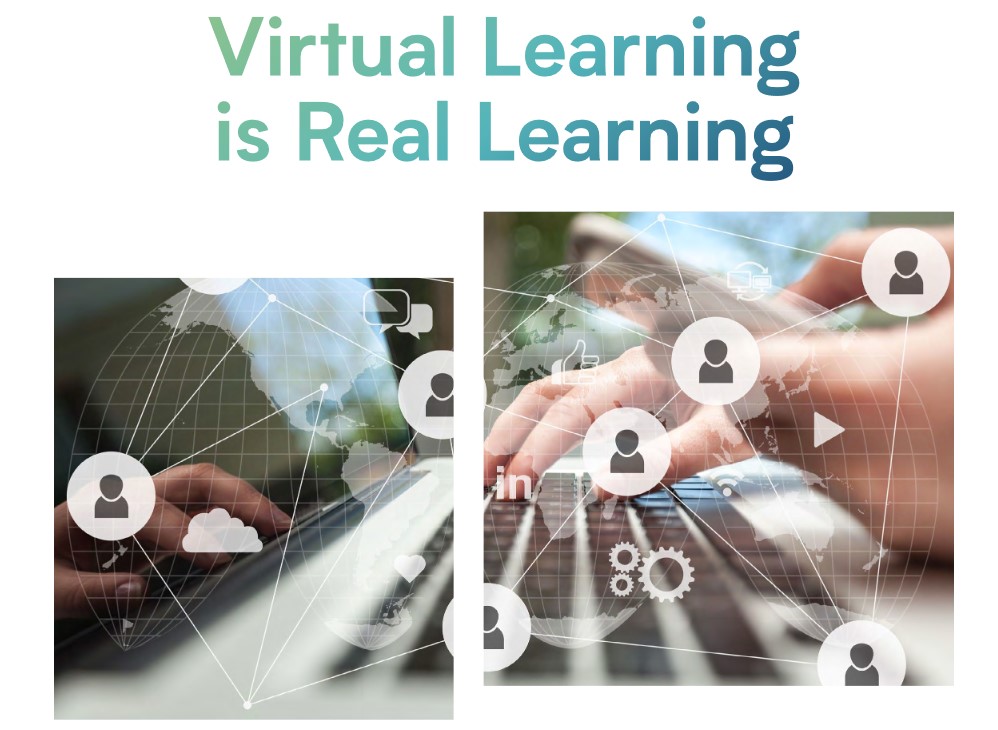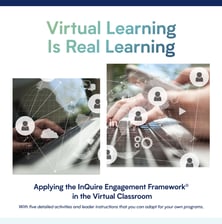Research Reveals Impact of Personal Video Cameras in Virtual Learning
We’re excited to unveil our latest research report “Video in Virtual Live – Effective Use of Personal Cameras in the Virtual Live Learning Environment
6 min read
 Jennifer Lindsay-Finan
:
Mar 16, 2023 12:03:00 PM
Jennifer Lindsay-Finan
:
Mar 16, 2023 12:03:00 PM

Learner engagement is the the most important part of any training program. It’s the most important part because an engaged learner produces better outcomes–engaged learners learn!
How engaged are your virtual learners? How do you even know if they’re engaged?
You might know learners are engaged based on the quantity and quality of their responses in a class. But how do you know how to actually engage them? How do designers know what will engage in the virtual classroom? How do facilitators and producers know how to keep learners engaged during a class?
responses in a class. But how do you know how to actually engage them? How do designers know what will engage in the virtual classroom? How do facilitators and producers know how to keep learners engaged during a class?
The problem is that historically, most of the best practices training professionals have been following have been based on anecdotal research. Many training professionals claim to "just know" what works and what doesn’t. Of course, we probably base a lot of that on our own past experiences and what we like best.
[Download Virtual Learning Is Real Learning - 60 pages of content you can use right now]
Dr. Charles Dye, InSync’s Director of Research and Evaluation, spent years researching learner engagement and identified the factors that make up our InQuire Engagement Framework. (You can access the original research here.) This framework is the foundation of everything we do here at InSync Training. It gives us the tools we need to design and deliver engaging virtual training programs every time.
The InQuire Engagement Framework is grounded in neuroscience and cognitive psychology and psychometrics. Above all, it’s based on data–so we know it works. The framework is comprised of these three dimensions:
This model can be applied to absolutely any kind of learning environment–not only virtual classrooms. Even as the environment itself changes throughout a blended program, the environmental engagement is still as important.
It's critical to remember that all three dimensions are equally important and that each of the dimensions affects the other two.
As much as each dimension is closely connected with and affected by the other two dimensions, let’s consider each dimension in turn.
We know intuitively that emotional engagement is important–we want our learners to enjoy the experience and feel like the learning event is worthwhile. Emotionally engaged learners feel a sense of belonging, that they’re part of the learning community and their opinions matter. They feel psychologically safe enough to ask questions and contribute to the learning. They enjoy it and want to be there.
We all know emotional engagement is important because without it, learners wouldn’t contribute. If they’re not enjoying the experience, they won’t continue giving green checks or answering in chat. They wouldn’t want to be there and that energy would rub off on the other learners and would affect their engagement intellectually and environmentally too.
Environmental engagement involves everything about the learning experience except for the learner themselves. It includes the other learners, the facilitator, the virtual platform, and the technology. It also includes background noise, distracting virtual backgrounds, and anything going on in their own physical environment (such as colleagues, pets, or email notifications).
Environmental engagement is important because we want our learners to contribute. We want them to have a technically smooth experience so that they can focus on the content. We’ve all no doubt been in a virtual classroom when something went wrong. Consider how that impacted your engagement. If a learner cannot access the annotation tools in a virtual classroom, are they still able to collaborate on the activity or do they feel excluded? If a learner can’t hear the audio clearly, they’re going to feel frustrated because they’re missing so much. It’s not always about the technology though. If one learner takes over and talks so much that the others can’t get a word in, it's going to impact everyone. If a learner has any barrier which prevents their contributing and being fully involved in the learning experience, it’s going to affect their emotional engagement and their intellectual engagement too.
Since we know that curiosity improves learning and memory, we know that it’s important to engage our learners intellectually. When learners are engaged in a way that allows them to make real-life connections with the content, we know they’ll be much more likely to apply that learning back at work. Learners are intellectually engaged when they really want to know the answer to something or master the skills being taught. They see a reason why they should learn the content and are accountable for their own learning.
Without intellectual engagement, without that need to know, learners will quickly tune out–especially in a virtual class where it’s easier to switch to answering emails. When learners are not intellectually engaged, they’ll be much less likely to participate. Their environmental engagement will dip and there won’t be a need for them to be emotionally engaged either.
[Download Virtual Learning Is Real Learning - 60 pages of content you can use right now]
Much of the research behind the InQuire Engagement Framework™ affirmed that we have already been engaging learners in the virtual classroom for years. But how is it different? I've got three opinions.
order for multiple adjectives, yet we intuitively know that "the white big dog" is wrong, and "the big white dog" is correct. When we learn there is a rule, it reassures us that we know what we’re doing.
We’ve always intuitively known that introductions are a good thing at the start of a learning program, but we’ve not always been able to explain why. Now that we understand the role emotional engagement plays, we can better understand that introductions help our learners connect with each other and feel more comfortable contributing in class.
It’s not about us. Most training professionals will incorporate activities that they themselves enjoy and avoid the ones they dislike. If you like to be able to speak up whenever you like, you’re more likely to expect your learners to do that too, which means you might not always hear from the quieter learners in your class. But it’s not about us. It’s about the learners and what is right for them. Because we know that environmentally engaged learners know exactly how and when to contribute during a class, we know that it is important to always tell learners how to respond.
It makes evaluations fair. The InQuire Engagement Framework™ leads to consistency across the whole instructional team which allows for true evaluation of the training. If the learner experience is not consistent and we’re not seeing results, then we don’t know for sure whether the lack of results is because of the training or not. With the InQuire Engagement Framework™, we know our designs are detailed and consistent. We know that every learner will have had the same experience in terms of activities they’ve participated in, and we know that if some learners are unable to transfer that learning into their work, and others can, it’s not due to the training. With the InQuire Engagement Framework™ we know that our facilitation teams are keeping learners engaged so that they leave training having had the experience our designers intended. Our producers support the facilitators to ensure engagement across all three dimensions.
For consistent, effective engagement, the entire instructional team must be focused on all three dimensions of the InQuire Engagement Framework™.
This is probably the biggest change when learners move to the virtual classroom. The environment changes from what they may have been used to in a traditional face-to-face classroom. Therefore, it’s important to help learners get comfortable in this new virtual environment. That goes way beyond including a tools overview. It means designing activities that make use of the most appropriate tool for the job. It means facilitating classes using the tools all learners have available and making accommodations for any learners without those tools. It means producers giving clear instructions and helping learners to get comfortable in the environment.
Remember that environmental engagement is about more than just the technology though. It’s also about ensuring that learners’ contributions change the environment. This means designing truly collaborative activities with effective debriefs that encourage each learner to build on what each other says. It means facilitating discussions where learners respond to each other, and that the facilitation team are using examples and stories that are relevant to the people present. It means the producer is restating instructions for those who need them and is acting as a learner advocate to ensure all learners are heard.
Those new to the virtual classroom may think that the emotional engagement is something that is missing when you’re not face to face, but it certainly doesn’t need to be. Ensuring emotional engagement means designing effective warmups so that everyone can participate straight away. It’s about facilitating in a fun, engaging manner, allowing and encouraging learners to enjoy themselves. It’s about building community by encouraging learners to work together, share ideas, and build connections in class. Producers can nurture emotional engagement by joining in with the conversations and reaching out to any learner who may need extra support or attention.
This starts with the design. Virtual Classroom Designers stimulate intellectual engagement through using an inquiry-based approach that aligns with the "what’s in it for me" for the learners. They use adult learning principles to design activities that encourage and motivate learners to collaborate. It’s not just about the design though. Facilitators ask great, thought-provoking questions to help learners truly understand the content and connect it to their own work. Producers support intellectual engagement by reinforcing key points in chat, highlighting key areas of a slide or acting as a learner advocate when they notice a muddy point.
There is so much more to learn! Click the graphic below to download the eBook now. It's worth the click :)

We’re excited to unveil our latest research report “Video in Virtual Live – Effective Use of Personal Cameras in the Virtual Live Learning Environment

This article explores the impact of live video in virtual learning, analyzing whether it boosts engagement or increases distraction based on InSync...